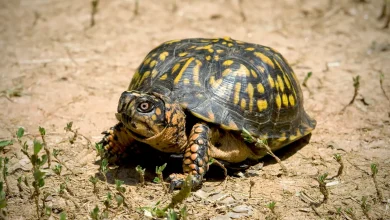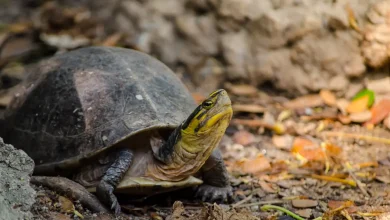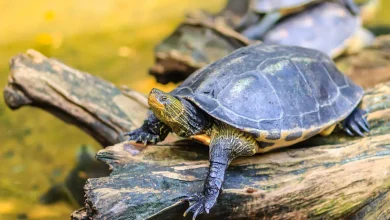Yunnan Box Turtle (Cuora yunnanensis)
The Yunnan box turtle is an Asian box turtle in the genus Cuora. The species was first described in 1906 and the species was long thought to be extinct since the last specimen was seen in 1940
- Cuora yunnanensis – Boulenger, 1906
In 2004, more than 60 years after the last specimen had been seen, a live female specimen appeared in the pet trade in Kunming. A year later a male turtle also made its way to Kunming. Yet another year later another female was found. The initial reports that the Yunnan box turtle had been rediscovered were met with scepticism and many believed that these turtles were man-made hybrids that were supposed to look like the Yunnan box turtles. Not true Yunnan box turtles. Genetic testing in 2007 did prove that these turtles were indeed pure Cuora yunnanensis.
The species is listed on the IUCN Red List.
KINGDOM: Animalia
PHYLUM: Chordata
SUBPHYLUM: Vertebrata
CLASS: Reptilia
ORDER: Testudines
SUBORDER: Cryptodira
SUPERFAMILY: Testudinoidea
FAMILY: Geoemydidae
GENUS: Cuora
SPECIES: Cuora yunnanensis
By Cuora at English Wikipedia, CC BY-SA 3.0, https://commons.wikimedia.org/w/index.php?curid=41996821
This species is known under a number of different synonyms:
- Cuora yunnanensis – Boulenger, 1906
- Cyclemys yunnanensis – Boulenger, 1906
- Cyclemys yannanensis – Boulenger, 1907
- Cuora yunnanensis – Smith, 1931
- Cuora vunnanensis – Wermuth & Mertens, 1977
- Pyxiclemmys yunnanensis – Vetter, 2006
Table of Contents
Cuora yunnanensis Distribution
Wild Yunnan box turtles were only discovered in 2008 when Kadoorie Conservation China, the Kunming Institute of Zoology and the Chinese Academy of Sciences discovered a small wild population. The true distribution of this species remains unclear. The fact that the species was able to stay hidden for so long proves their ability to hide. Only one small population isolated to one site is known. This site is now being closely monitored by scientists local wildlife managers and villagers.
Yunnan box turtle Habitat
The Yunnan box turtle is as earlier mentioned only found from one single location. They are a mainly aquatic species that are found in areas that offer plenty of hiding spaces on the river banks and below the surface of the water. The Yunnan box turtle is a shy species and is seldom found far from cover.
By Cuora at English Wikipedia, CC BY-SA 3.0, https://commons.wikimedia.org/w/index.php?curid=3462335
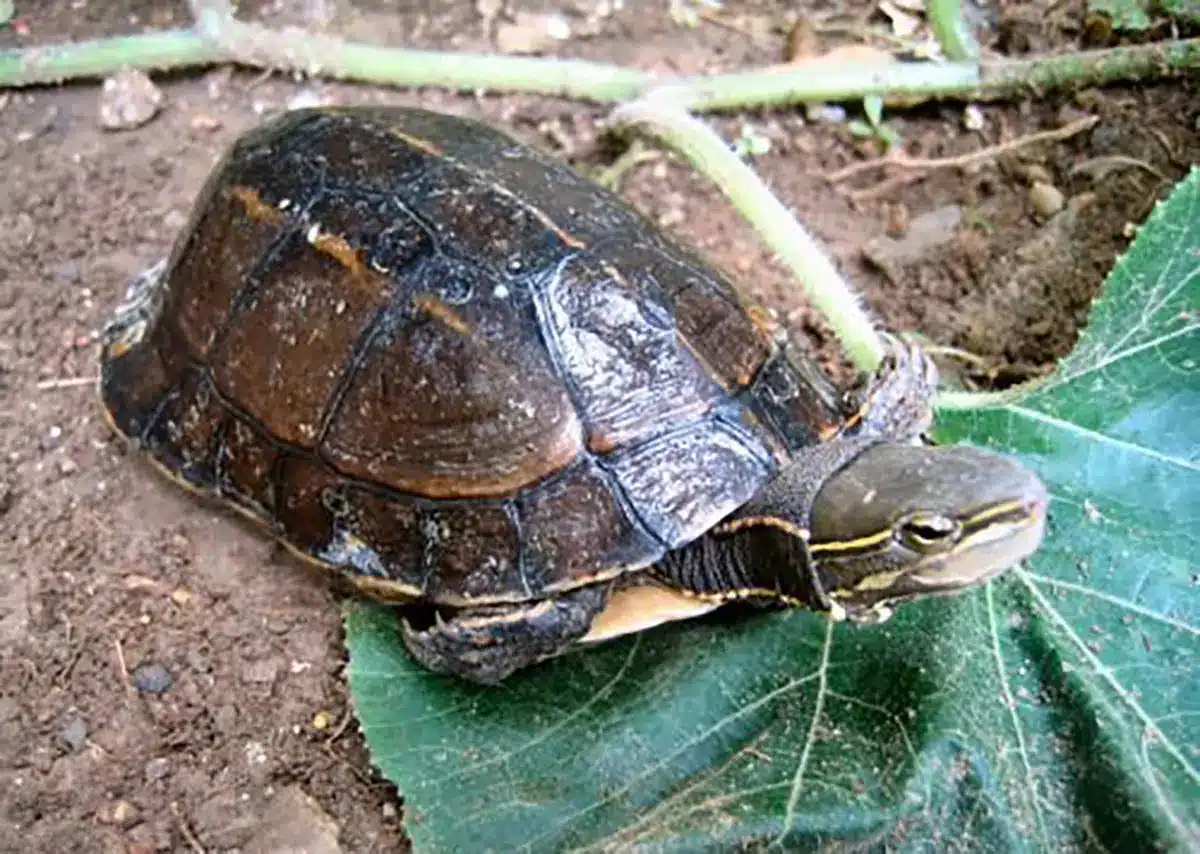
Body
The Yunnan box turtle has a brown rather high domed carapace. The carapace has a light edging and the individual shields in the carapace have dark edging. It has a yellowish flexible plastron.. The head is pointy, and olive green with yellow striping. The limbs and tail are usually darker than the head. This species has a very long extendable neck.
The females grow to be 17.5cm/7 inch CL while females seem to top out at 15cm/6 inch CL.
What does the Yunnan box turtle eat?
Next to nothing is known about the diet of Cuora yunnanensis in the wild. It can, however, be assumed that they are omnivorous species with a preference for meaty food. Looking at how far their neck can extend one can make an educated guess that they catch and feed on small fish found in their natural habitat. They are however also likely to catch and eat crayfish, shrimp and different types of insects.
How old can a Yunnan box turtle get?
There is no conclusive information on the maximum age of Yunnan box turtles.
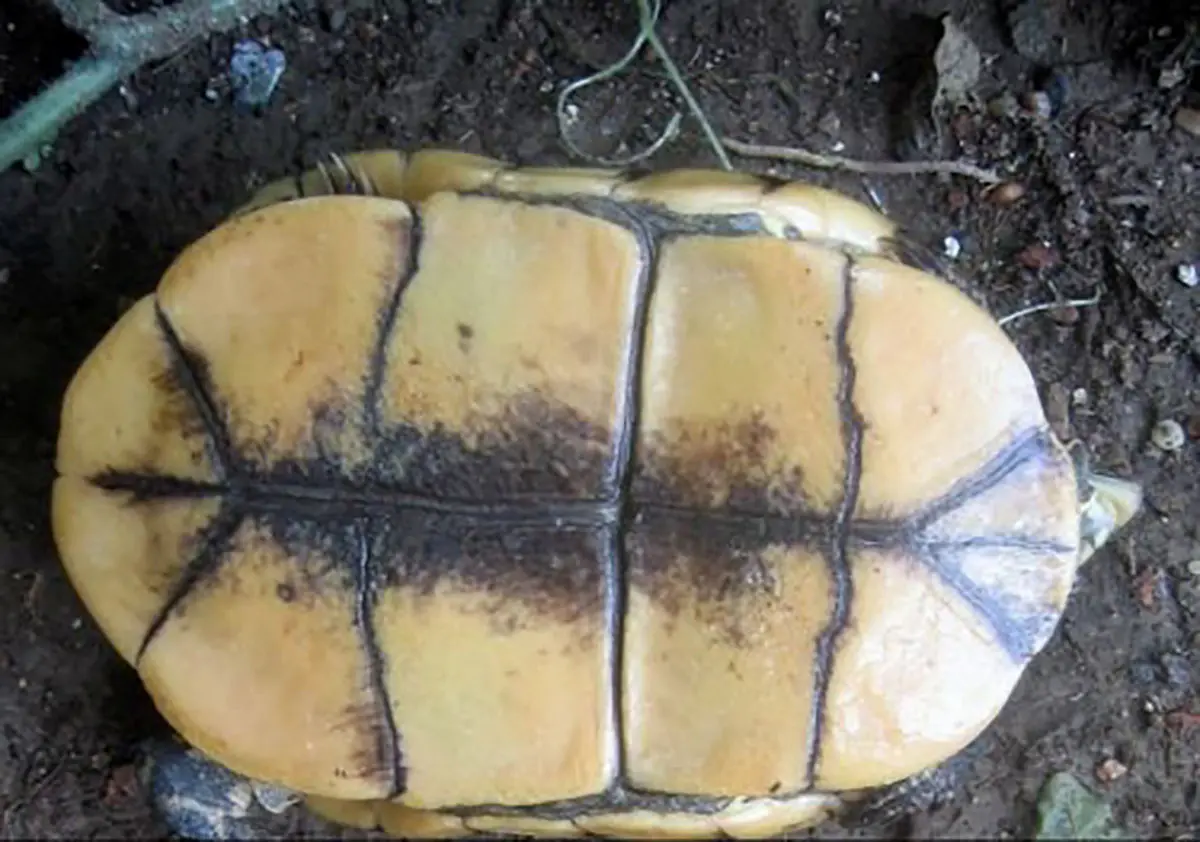
Keeping Cuora yunnanensis as a pet
The Yunnan box turtle is as far as I know not available in the pet trade at the moment. The large sums that are paid for rare turtles do however mean that some specimens might have made it into the pet trade. Most likely either before the species was rediscovered in 2004 or through illegal exports after the species was rediscovered. Some rumours say that several specimens have made it out onto the international black market for pets. The animals are supposed to sell for many thousand USD each and the first exported animal might according to rumours have fetched as much as USD 50,000.
Anyone who believes they have a Yunnan turtle in captivity should contact the Asian Turtle Conservation Network (ATCN), The Turtle Survival Alliance, the Asian Turtle Consortium and other similar organizations so that the turtle can be registered and be a part of breeding efforts. Yunnan box turtles have been bred in captivity since 2006 (Ting Zhou) as a part of conservation efforts and an officially sanctioned assurance colony has been set up under the oversight of Professor Rao Dingqi. The colony was set up using a few animals from the wild population as well as animals saved from food markets and from homes in the village near where the wild population was discovered.
The captive breeding has so far been somewhat successful and hopefully, it will be possible to release a limited number of Yunnan box turtles to individuals and institutions that have good records with other Cuora species such as the Münster Zoo in Germany.
Housing a Yunnan box turtle
There is very limited information available about the housing of these turtles and the information provided here is based on the setups used for the assurance colony. It is important to remember that the assurance colony is set up in an area with a climate similar to the climate in the natural habitat of Cuora yunnanensis and this has to be taken into consideration if ever setting up a habitat for the Yunnan box turtles anywhere else.
In the assurance colony rubber maids with two different compartments are used to house the turtles. One section is kept filled with water to provide them with an aquatic habitat. The other section gives the turtle a land and nesting area. The land area is planted to provide these shy turtles with cover. The aquatic area features floating plants under which the turtles can seek cover. No other decorations are used to make the habitats easy to clean.
A shade cloth that can easily be retracted is used to regulate sunlight and temperature.
The Yunnan box turtle lays one or two clutches of eggs each year. Each clutch contains 4 to 8 eggs. They seem to produce a maximum of 8 eggs per year. A female that lays 8 eggs in one clutch will normally not lay a second clutch of eggs that year. The eggs hatch after 64–68 days of incubation at 28–30°C. (Zhou et al . 2008). A lower incubation temperature seems to produce more males. The hatchlings measure 32–35 mm when they hatch.
Feeding a Yunnan box turtle
There is very little information available on the feeding of Yunnan box turtles but it is safe to assume that they do well on a diet based around a high protein fish pellet (30%+) complemented with live fish, small crayfish, shrimp, earthworms, snails and other meaty food. They should also be provided with fruit and vegetables such as sliced bananas at least once a week.
Once thought to be gone forever, a few Yunnan box turtles were discovered alive in 2005 at a place that scientists still keep secret. These rare survivors are now protected in a special breeding program, giving hope that the species can be saved from extinction.
According to Conservation International, Yunnan box turtles can sell for almost $10,000 each on the illegal market.
References
- Blanck, T., Zhou, T. & W. P. McCord. 2006. The Yunnan box turtle, Cuora yunnanensis (BOULENGER 1906); historical background and an update on the morphology, distribution and vulnerabilities of the only known living specimens. SACALIA 13 (4), 2006: 14-35.
- UCN Red List http://www.redlist.org
- Boulenger, GEORGE A. 1906. Descriptions of new reptiles from Yunnan. Ann. Mag. nat. Hist. (7) 17 (102): 567-568.
- Ernst,C.H. 1988. Cuora mccordi, a new chines box turtle from Guangxi Province. Proc. Biol. Soc. Washington 101: 466-470.
- Fong, J.J. & Qiao, G.X. 2010. New localities of endangered Chinese turtles from museum specimens and the practical and ethical challenges using and reporting natural history collection data. Zootaxa 2393: 59–68.
- Iverson, J. B. 1992. A Revised Checklist with Distribution Maps of the Turtles of the World
- ZHOU, T. 2005. Discovery of a Living Male Yunnan Box Turtle, Cuora yunnanensis BOULENGER, 1906. (in Chinese). Sichuan J. Zool., Chengdu 24 (3): 345-346.
- ZHOU, T; P-P Li. 2007. Chelonian species diversity and current status in China. (in Chinese). Sichuan Journal of Zoology 26 (2):463-467.
- Zhou, T., and E. Zhao. 2004. On the occurrence of living Cuora yunnanensis since fifty-eight years, and its description. Sichuan Journal of Zoology 23 (4): 325-326.
- Zhou, Ting, William P. McCord, Torsten Blanck and Xiao-feng Sun. 2008. Rediscovery and first breeding of the Yunnan Box Turtle. Reptilia (GB) 59:29-34.
